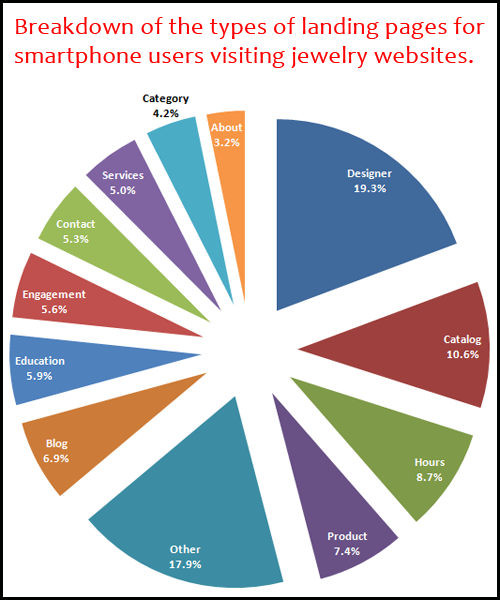
We know from yesterday's Daily Golden Nugget that people who browse jewelry websites prefer the iPhone over the Android. In this edition of the Daily Golden Nugget, I'm investigating exactly what mobile visitors are searching for.
During the month of September 2014, I collected and analyzed all the landing pages for mobile visitors across more than 100 retail jewelry websites. I'm particularly interested in the landing pages for these mobile visitors because that provides a hint of what the person was searching for.
A landing page is the first page of the website the person sees when clicking on a link from search results; in other words, this is the page they 'land' on.
You might think that website visitors only enter your website through your home page, but that's not always the case. In fact, the mobile visitor lands on the home page only 62% of the time, the rest of the time the mobile visitor lands on some other page of the site.
Excluding the home page of a website, I grouped all other pages into 12 possible categories to create this pie chart:

| Page Type | Landing Popularity |
| Designer | 19.30% |
| Catalog | 10.60% |
| Hours | 8.70% |
| Product | 7.40% |
| Blog | 6.90% |
| Education | 5.90% |
| Engagement | 5.60% |
| Contact | 5.30% |
| Services | 5% |
| Product Category | 4.20% |
| About | 3.20% |
| Other | 17.90% |
By far the mobile user is searching for specific jewelry designers. More than 19% of users are stimulated to search for a specific jewelry designer name while they are out and about in the world. Perhaps it was a billboard, a radio commercial, or even talking to a friend. This is a clear indication of the Zero Moment of Truth.
The 2nd most popular landing page is a jewelry product catalog with more than 10%. These visitors are doing generic jewelry searches and browsing through online catalogs. If you don't have a catalog on your website yet then this should be a strong motivating factor to add one, and to make sure it works on a smartphone.
You should find the 3rd most popular page quite interesting, it's the store hours page. Almost 9% of mobile users simply wanted to know what time their jeweler was open. These mobile users are probably already existing customers, or they're simply in a rush to find a nearby jeweler.
Next we have a group of mobile users that were searching for a specific product and they clicked on it from the search results. More than 7% of mobile visitors landed on an individual product detail page. Perhaps they searched for a specific style number or they just knew exactly what they were searching for. Product detail pages usually don't appear in search results unless the user is typing a very long search phrase.
The blog pages come in at 5th place and jewelry education pages come in as the 6th most popular pages landed on by mobile visitors. The last time I did this type of analysis the blog pages also came in at 5th place. This shows the continued importance of content building.
I was especially careful to isolate out all the mobile users who landed on pages relating to engagement rings. The table above show engagement pages at 7th place with 5.6% of mobile landing page traffic. Could it be that 5.6% of your mobile visitors are suddenly realizing that it's time for them to take that important step in life?
The contact page isn't as popular as the store hours page. I have to assume that 5.3% of mobile visitors are looking for a telephone number.
The jewelry services page is 9th in the list. It shows that 5% of mobile visitors were looking for some type of service, which might include repairs, appraisals, or ear piercing.
I was able to group together all the mobile users that were looking for a specific category of jewelry. Shown as the 10th item in the table above, Product Categories, like bracelets, rings, necklaces, and earrings, were on the mind of 4.2% of mobile users.
The last set of pages I grouped together had something to do with a jeweler's store history or a general description of the store. These about pages were landed on 3.2% of the time.
Even though I've already thrown a lot of percentages at you today, let me throw one more. As of this writing the percentage of mobile users to your website has already exceeded 40%, and this number will continue to climb. Mobile users usually search with specific intent, and Google has gotten really good at matching those intentions to website content.
Hopefully this information will be a guide as to the type of content that you need on your website in order to attract those mobile users.








